
Latest News
Teterboro Airport is monitoring an expected winter storm forecast to impact the region from Friday into Saturday. While overall traffic volume is anticipated to be lower, winter weather conditions may require the implementation of a formal deicing program to ensure safe and efficient departure operations.
To avoid excessive surface delays and the potential for aircraft to require multiple deicing applications, operators are reminded of how the TEB deicing process functions and the importance of strict readiness prior to entering the deicing queue. Aircraft that are not fully prepared risk extended delays and loss of departure opportunities. Please be aware that during single-runway operations, any immediate stop—such as a NIL braking action report—has a substantial operational impact. Aircraft taxiing, holding short, or actively being deiced may be required to return to the ramp and undergo deicing again, further compounding delays.
Pilot Deicing Responsibilities – Key Reminders:
- Obtain an IFR clearance from TEBT Clearance Delivery as soon as it becomes available.
- Coordinate with your FBO ramp boss to be placed on the deicing list.
- Communicate any departure restrictions issued by Clearance Delivery, including EDCTs. Please note that EDCTs are wheels-up times, and ramp sequencing is adjusted accordingly.
- Prior to deicing, verify the aircraft is fully ready to taxi, including:
- IFR clearance received
- All passengers and crew onboard
- All baggage and fuel loaded
- Aircraft configured and ready to taxi, except for deicing
- Once deicing is complete and you are notified by the ramp boss, proceed in accordance with ATC instructions.
During a formal deicing program, TEB will normally activate the Gate Hold position to meter traffic in accordance with minutes-in-trail departure restrictions and to allow Ground Control to focus on movement areas. The Gate Hold frequency is 120.675.
However, during periods of reduced traffic volume, pilots may be instructed to contact TEBT Ground Control directly when ready to taxi instead of Gate Hold. Guidance on who to contact and when during these events will be published on the ATIS and should be reviewed prior to taxi.
Pilots are requested not to contact TEBT after receiving clearance until deicing is complete and the aircraft is ready to taxi. Field condition updates will be available through ATIS and/or Clearance Delivery.
Early coordination between flight crews, FBOs, and airport stakeholders remains critical to maintaining safe and efficient operations during winter weather events. Once aircraft enter the movement area, available corrective actions become extremely limited.
Please feel free to reach out to the tower if there are any questions or concerns. Thank you for your continued cooperation and proactive planning as we prepare for this weather event. Happy Holidays.
Cordially,
Marina M. LeBron
FAA Operations Manager, ATO
Teterboro ATCT
500 Fred Wehran Dr.
Teterboro N.J. 07608
Work: 201-426-9466/9500
Click here for 2025-2026 KTEB Pilot’s Deicing Responsibilities
Click here to view TEB Construction Bulletin #1225-6 concerning all scheduled Runway and Taxiway closures during the period of Wednesday, December 31st through Friday, January 9th.
Good morning,
As a reminder, today, December 18th, through Saturday, December 20th, are expected to be the busiest air travel days of the year across the National Airspace System (NAS). This is no different at Teterboro as increased traffic is anticipated with holiday travel.
To help mitigate southbound departure delays, all users are strongly encouraged to proactively file flight plans that avoid the WHITE departure gate when operating southbound. LANNA, PARKE, and DIXIE (for aircraft capable of deep-water operations) are effective alternatives and will help reduce delays and improve overall departure flow.
Additionally, weather is forecast to impact the area overnight tonight through early Friday afternoon, December 19. Current forecasts indicate widespread rain with the potential for convective activity, and there is the possibility of a SWAP event that could further impact departure operations Friday morning. Users are encouraged to remain proactive by reviewing the most current weather information and NOTAMs and by assisting Air Traffic Control through the timely dissemination of PIREPs.
A significant departure push is expected on Friday and Saturday. While ATC will make every effort to move traffic as safely and efficiently as possible, weather-related restrictions may limit available options, and delays should be anticipated during periods of hazardous weather.
All users are requested to ensure that parking and service reservations are confirmed with their FBO of choice so ramps can plan accordingly for arrivals and departures. FBOs are also asked to notify TEB Operations and the Control Tower as early as possible of any potential ramp congestion or gridlock scenarios, as early coordination greatly enhances operational planning.
Thank you for your continued cooperation throughout the year. I look forward to continued coordination in 2026. On behalf of the TEB team, I wish you a safe and happy holiday season with your family and friends.
Matthew Petersen
Air Traffic Manager (A)
Teterboro ATCT
We will hold our regularly scheduled 4th Quarter TUG GoToMeeting event on Wednesday, December 17 from 1000 to 1200 EDT.
4th Qtr TUG GoTo Meeting
Dec 17, 2025, 10:00 AM – 12:00 PM (America/New_York)
Please join my meeting from your computer, tablet or smartphone.
https://meet.goto.com/852960405
You can also dial in using your phone.
Access Code: 852-960-405
United States: +1 (312) 757-3121
Get the app now and be ready when your first meeting starts:
https://meet.goto.com/install
Please join my meeting from your computer, tablet or smartphone.
https://meet.goto.com/852960405
You can also dial in using your phone.
Access Code: 852-960-405
United States: +1 (312) 757-3121
Get the app now and be ready when your first meeting starts:
https://meet.goto.com/install_York)
Please join my meeting from your computer, tablet or smartphone.
https://meet.goto.com/390754125
You can also dial in using your phone.
Access Code: 390-754-125
United States: +1 (872) 240-3412
Get the app now and be ready when your first meeting starts:
https://meet.goto.com/install
AGENDA
- Sherri Smith, PANYNJ Airport Manager, and Scott Marsh, Manager Airport Operations and Security, will provide an Airport Operations update. PANYNJ
- Matt Petersen, FAA, Air Traffic Manager, Teterboro ATCT, will review best practices to maximize safety and efficiency. FAA
- Pete Whitten, OdiliaClark, Commercial Director, will outline and explore what effective Peer Support looks like in corporate and business aviation today, and why it is increasingly recognized globally as a key competent of psychological safety and operational resilience. https://odiliaclark.com/aviation/
- Chris Gomes, FAA, Operational Safety Analyst, Office of Accident Prevention and Analysis, will provide an update on discussions regarding NY/NJ Airspace redesign efforts to reduce TCAS TA/RA events.
- Ralph Tamburro, PANYNJ Airport Delay Reduction Program Manager, will discuss SWAP and the Terminal Flight Data Manager as they relate to delay mitigation at Teterboro and throughout the NY Metroplex. PANYNJ
- Terri Riotto, APHIS Wildlife Services,Wildlife Biologist, will discuss wildlife management efforts and strike reporting.. Aphis USDA Wildlife Services and PANYNJ
- Gabe Andino, Avports Noise Abatement and Environmental Compliance Manager, will address recommendations for using Rwy 19 for night Departures. Avports
Please make every effort to participate, and invite others from your organizations. All are welcome!
Feel free to send any questions or suggestions with respect to these planned presentationf in advance via TUG’s “Contact Us” link on the upper right corner of our website.
Cameras for HPN & TEB are live on https://weathercams.faa.gov/. TUG participated in the selection of the location and direction of these cameras. We’re grateful to the FAA for completing this initiative in such a timely fashion from planning to implementation.
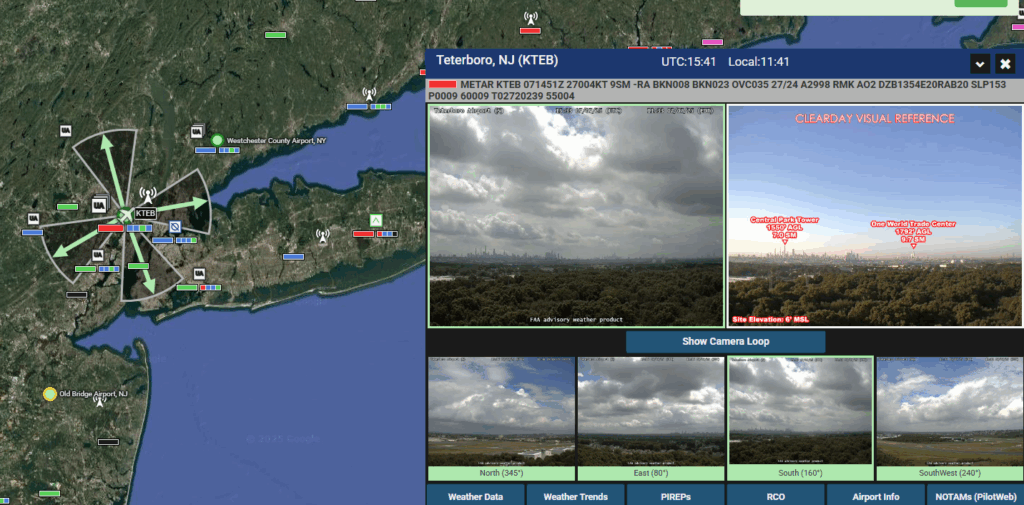
TUG President Dave Belastock represented operators in NBAA’s May 20 News Hour panel discussion with NBAA and FAA to address “Northeast Airspace Disruptions – Strategies for Decision-Making and Delay Mitigation”.
”The headlines have recently been dominated by news of outages in the Northeast’s busiest airspace, which are creating new complexities for business aviation operators. As the FAA urgently works on solutions, NBAA invites flight crews, schedulers and operators to a timely News Hour webinar. Representatives from the FAA, the Teterboro Users Group (TUG) and the industry will share available resources for navigating these challenges with confidence and compliance. This session will ensure you have the tools and peace of mind for operating strategically and safely, in the Northeast and throughout the aviation system.”
Click here to view the recording.
| Washington, DC, May 14, 2025 – While the National Airspace System (NAS) remains the world’s safest, recent equipment outages across one of the nation’s busiest sectors have rattled pilots and air traffic controllers (ATC) alike. As the Federal Aviation Administration (FAA) works to resolve these challenges across the Northeastern U.S., the National Business Aviation Association (NBAA) urges business aviation flight crews to approach the situation with level heads and work strategically within established procedures. On May 12, Transportation Sec. Sean Duffy announced the formation of a “tiger team” task force dedicated to resolving issues in the Philadelphia Terminal Radar Approach Control (TRACON Area C) sector that controls airspace overlying multiple New York City-area airports. Solutions in the works include adding three new, high-bandwidth feeds between the New York-based Standard Terminal Automation Replacement System (STARS) and the Philadelphia TRACON to provide greater speed, reliability and redundancy. The FAA is also deploying a temporary backup system to maintain communications, with plans for a dedicated STARS hub for the Philadelphia location. Additional controllers are also part of the solution. The FAA noted Area C currently has 27 fully certified controllers and supervisors on duty, with an additional 21 in training. Of the latter, 10 are receiving on-the-job training to cover additional sectors but are already certified on at least one position, with three certified on multiple positions. In the near term, however, flight crews should expect possible traffic management initiatives in the region, which may impact operations to and from some of the area’s busiest general aviation airports including New Jersey’s Essex County Airport (CDW), Morristown (MMU) and Teterboro (TEB). “NBAA is in direct dialogue with the FAA to work through this situation,” said Heidi Williams, NBAA senior director of air traffic services and infrastructure. “We encourage business aviation flight crews to consider their alternatives before wheels up. Think strategically, as always, but remain flexible in your plans.” For example, congestion at TEB may drive crews to file Westchester County Airport (HPN) as an alternate, leading to similar delays at that New York airport. “Consider and plan for additional alternatives outside the immediate area or drop and go operations could be an option,” Williams said. “Pilots may also consider tankering additional fuel in the event of delays or reroutes.” NBAA also urges pilots to utilize flight planning resources available from both NBAA and the agency. That includes subscribing to Airspace/Airport Alerts from NBAA Air Traffic Services, and staying updated on the status of the National Airspace System through nasstatus.faa.gov. Additionally, NBAA will host a live News Hour webinar early next week featuring expert guidance on the procedures and tools in place to manage operations in the near term and how to ensure business aviation flights in the sector support the highest levels of safety. Williams stressed crews should not attempt to deviate from established airspace procedures. “We recognize the challenges and strongly encourage crews to keep level heads, exercise patience and thorough preflight planning, and we’ll get through this together.” |
| Contact: Dan Hubbard, 202-431-5970, [email protected] |
Washington, DC, May 8, 2025 – Today, the National Business Aviation Association (NBAA) joined more than 50 other industry groups to express strong support for Department of Transportation (DOT) Secretary Sean Duffy’s proposal for a comprehensive upgrade of the nation’s air traffic control (ATC) system, which serves approximately 45,000 flights and 2.9 million passengers every day.
“Secretary Duffy’s plan cements America as a global leader in aviation, investing in both technology and the air traffic control workforce to enhance U.S. aviation safety and reliability,” NBAA President and CEO Ed Bolen said in remarks delivered at an event held in Washington, DC, to unveil the DOT plan. “The swift implementation of these updates is not just important, it’s imperative. We commend the Secretary for his focus on speed, efficiency, and safety and we fully support his call for Congress to provide the necessary funding.”
Importantly, a central focus of Secretary Duffy’s plan to modernize the ATC system focuses on implementing needed technological upgrades, enhancing connectivity and ensuring U.S. infrastructure can adapt to evolving technologies and increasing air traffic. Additionally, Secretary Duffy’s focus on accelerating the recruitment and training of air traffic controllers, which is part of his supercharge program announced in February, is a crucial step in addressing a longstanding workforce shortage.
In supporting Secretary Duffy’s plan, NBAA has joined the Modern Skies Coalition, (modernskies.com), a new group comprised of more than 50 industry organizations supporting the Administration’s plans to upgrade aviation safety and maintain America’s position as the global leader.
“We are deeply appreciative that Secretary Duffy has made our nation’s air traffic control system a priority and look forward to working with the Administration and Congress to bring this vision to fruition,” the coalition said.
The coalition applauded the Administration’s budget request of $4 billion for FAA’s technology and Facilities and Equipment (F&E), which is higher than ever before. The coalition also expressed appreciation for the Chairman of the House Committee on Transportation and Infrastructure, Sam Graves (R-6-MO), for taking a first step and moving $12.5 billion of ATC modernization funding through his committee.
At the same time, the group called for continued sufficient budget requests and an immediate robust infusion of resources to address soaring operational demands and enhance safety measures. “We believe a minimum of $18.5 billion in additional emergency funding should be appropriated over the next three years above the FAA’s annual F&E budget,” the coalition said in its statement.
Read the full Modern Skies Coalition statement here.
“The future of air travel in the U.S. depends on a robust and resilient air traffic control system,” Bolen concluded. “NBAA recognizes that maintaining safety and improving efficiency requires collaboration and investment from all stakeholders involved, and we stand ready to assist Secretary Duffy and the Administration in driving these essential changes.”
View a video of Ed Bolen’s remarks from the event introducing the DOT’s plan.
Review the full version of Ed Bolen’s prepared remarks for the event introducing the DOT’s plan.
As we migrate from Spring to Summer 2025, Teterboro Airport continues to see numerous operational constraints within the ATC environment. Many of these constraints are related to the transition of the Newark sector into the Philadelphia TRACON, Area C. While other challenges such as Newark construction and VIP Temporary Flight Restrictions add to the mix.
We are experiencing increased Area C staffing triggers which lower the arrival and departure rates for all four Newark sector airports (EWR, TEB, CDW and MMU). Staffing triggers can occur at the last minute and traffic management initiatives are required to manage the traffic with Ground Stops, Ground Delay Programs and/or an Airspace Flow Program which combine TEB, MMU and CDW arrivals as one.
With the variety of ATC Initiatives being used we recommend flight operators monitor the FAA ATC OIS webpage at https://nasstatus.faa.gov/ for up to the minute details on what initiatives are in place.
In addition, a major construction project at Newark Liberty Intl, including the closure of Runway 4L/22R through June 15, has added to the challenges. This runway closure necessitates the increased usage of arrivals to Runway 29 at EWR.
· On a south flow, EWR arrivals going to Runway 29 have a minimal effect on Teterboro operations.
· However, on a north flow the increased usage of EWR arrivals to Runway 29 will necessitate the need to transition from the ILS Runway 6 at TEB to the RNAV GPS X Runway 6 approach.
Another constraint will be Temporary Flight Restrictions associated with POTUS trips to Bedminster, NJ which typically ramp up as we head into the summer months.
· When the Bedminster TFR is active, General Aviation operations out of Teterboro, in addition to many other airports in the NYC Metro area, will lose access to the West departure fixes. Aircraft will need to file over the North and South departure fixes.
· Arrivals into TEB are also affected by the Bedminster TFR as arrivals from the south will need to reroute off the JAIKE arrival and either route up over Long Island and/or up over eastern PA.
· The Command Center will publish required routes when these TFR routes are active. They can be found on the FAA ATC Reroutes webpage at https://www.fly.faa.gov/ratreader/jsp/index.jsp
When Bedminster/KILMA TFR is in effect, the FAA recommends the following westbound routing in order to reduce congestion over COATE: GAYLE Q18
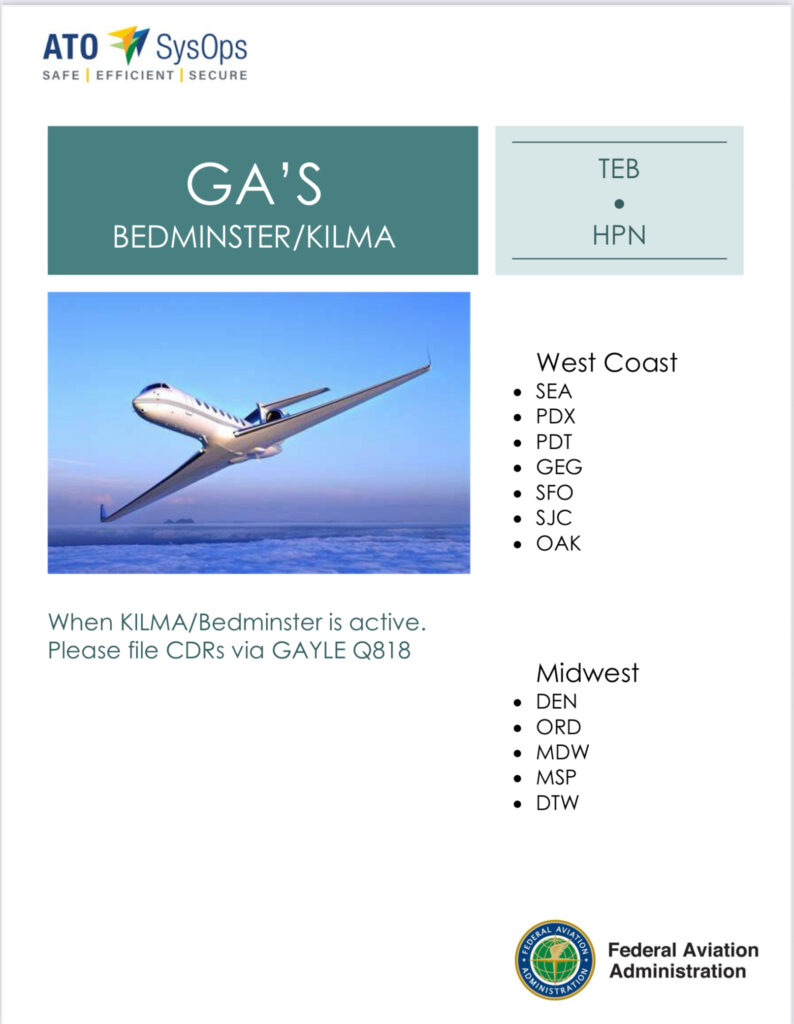
Click here to read this important LTA.
From FAA ATCT Manager Matt Petersen:
“I am reaching out with a request for your assistance in alleviating expected congestion in the airspace for aircraft flying southbound to Florida and the Caribbean over the next three days. I anticipate significant traffic over the WHITE departure gate and would greatly appreciate it if you could encourage pilots to file routes over alternate departure gates to help ease the flow of air traffic.
To mitigate delays and reduce congestion, we are kindly requesting that aircraft file their flight plans over one of the following alternate departure fixes: LANNA, PARKE, or DIXIE. DIXIE is only available to aircraft that are deep water capable. Ideally, aircraft filing over the LANNA or PARKE routings are landing on either the west coast of Florida or Central Florida, while aircraft filing over DIXIE are landing on the east coast of Florida south of Daytona Beach (DAB) or the Caribbean.
By utilizing these alternate fixes, we can expedite departures from the FBO ramps and help minimize delays caused by minute-in-trail restrictions over the WHITE departure gate. Your cooperation in communicating this routing change to pilots will greatly assist in achieving smoother operations and reducing congestion at the runway.
I sincerely appreciate any support you can offer in this matter.
Please find below the GA south bound Flyer developed by the FAA.”
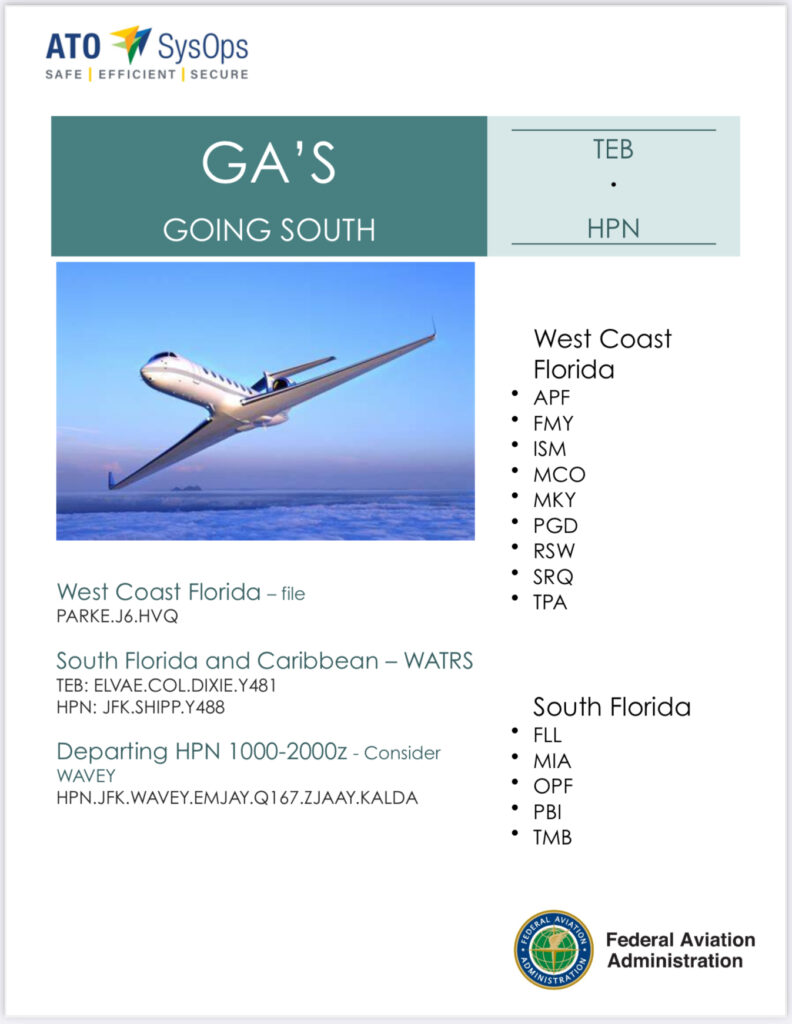
For any questions or concerns please contact:
Teterboro Air Traffic Control Tower at (201) 426-9457
Or
Teterboro Airport Operations at (201) 288-1775 Ext. 3
Effective March 1st, 2025, the U.S. Customs and Border Protection (CBP) main office located at Teterboro Airport’s Hangar 1 will adjust operating protocols permitting current FBO’s the ability for ground handling their respective international arrivals. Click here to read the Airport Managers Bulletin #2025-01.
Operators should contact their respective FBOs for further details pertaining to Hangar 1 International arrival procedures.
Signature TEB West, East, & South – Teterboro, NJ
As we continue to create an enhanced experience for you at Signature Teterboro (TEB), we are transitioning to a mandatory reservation policy at our TEB locations. Beginning Saturday, February 1, this policy will take full effect in order to meet guest needs, streamline operations, and ultimately reduce gridlock and aircraft taxiing time so that we are able to create an exceptional experience for you at every turn.
Reservations Required: We ask that you make a reservation prior to your arrival at any of our TEB locations. This can be done easily through our online reservation system or by calling our local guest experience team at +1 201-288-1880. If you need changes or to cancel existing reservations in the future, please inform us at your earliest convenience.
No Reservation Fees: While reservations will be required, there will be no fees to make a reservation. However, there will be a fee associated with landing without a prior reservation. Failure to make a reservation six hours or more before your time of arrival or departure will result in a No Reservation fee.

Need to Make a Reservation?
Visit any of the TEB Terminal Pages, contact our TEB team directly at +1 201-288-1880 or email [email protected]. Our guest experience team is ready to assist you with any questions or special requests.
Attached please find a copy of TEB Airport Operations Bulletin (AOB) # 2025-1 Runway 1-19 Stub Taxiway Re-designation, which provides information on an upcoming major change to the airport taxiway system.
TEB FBO Partners: please print the second page of this bulletin and post it in flight planning rooms, briefing rooms, and pilot lounges.
TEB Airport Operations can be reached at (201) 288-1775 Ext. 3.
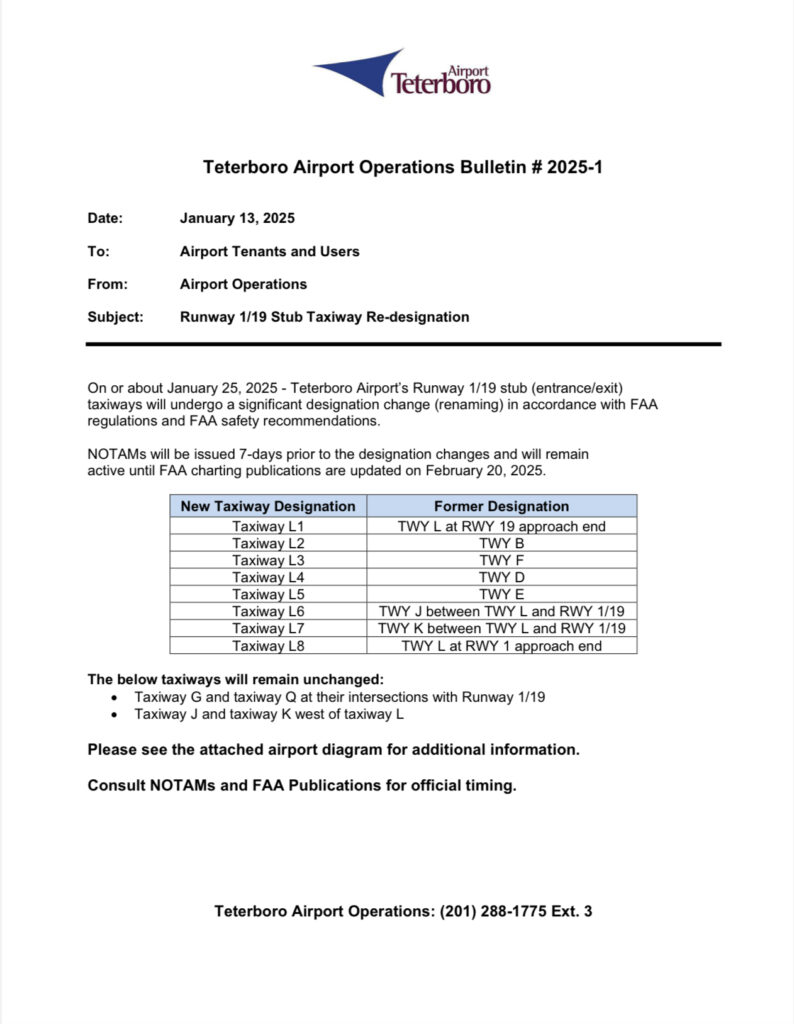
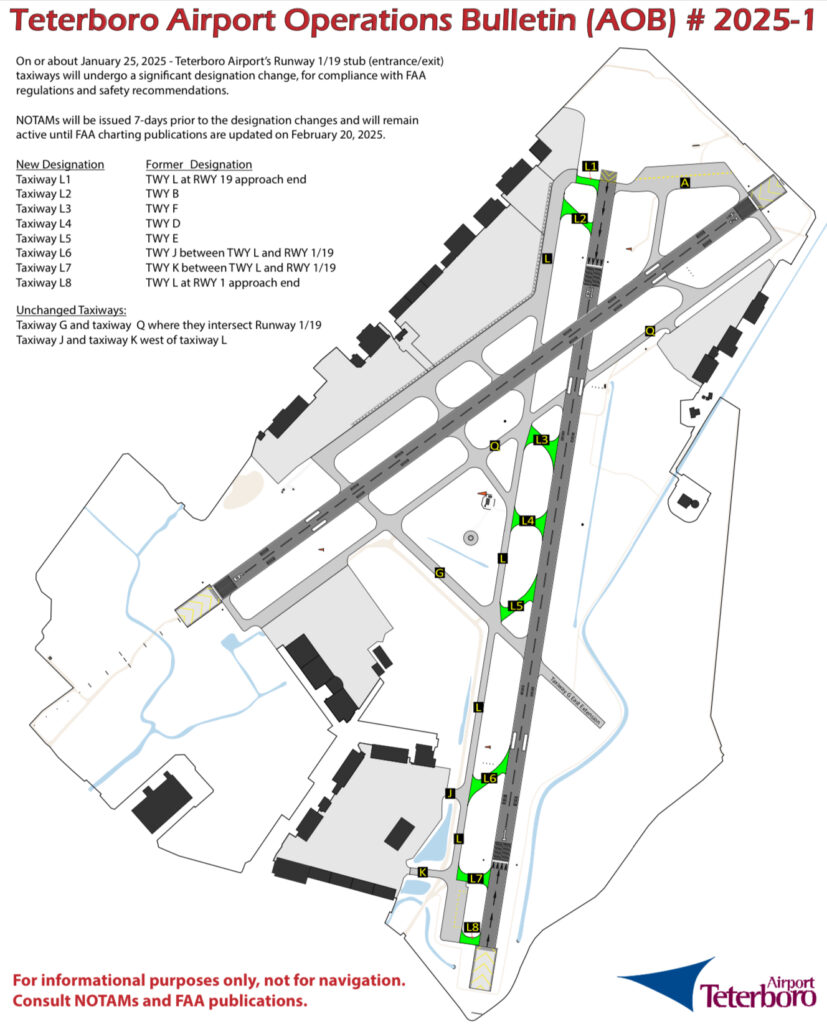
Did you know?
Your membership dues enable TUG to finance the Teterboro ATIS landline. Plug the following telephone number into your mobile phone and you'll always have the Teterboro ATIS at your finger tips: 201-288-1690.
